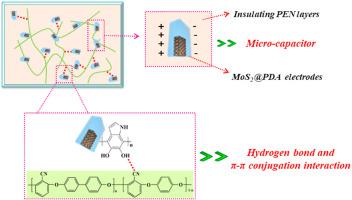Materials Science in Semiconductor Processing ( IF 4.2 ) Pub Date : 2021-08-07 , DOI: 10.1016/j.mssp.2021.106127 Mengna Feng 1 , Deyu Ma 1 , Xuanrong Chen 2 , Pan Wang 3 , Jing Lin 2

|
Polymer-based dielectric composites are potential substitute dielectrics for organic thin film capacitors. In this work, the exfoliated molybdenum disulfide (MoS2) was functionalized by mussel-inspired poly(dopamine) (PDA) to form core-shell structured composites (MoS2@PDA) under easy-handling and eco-friendly conditions, and then as filler incorporated into poly(arylene ether nitrile) (PEN) matrix. The interfacial interaction and dispersion of MoS2@PDA in PEN matrix were improved by the strong adhesion of PDA interlayer to exfoliated MoS2, π-π conjugation and hydrogen bond interactions, which formed by the polar nitrile group of PEN and catechol groups of PDA. Therefore, the PEN/MoS2@PDA composite films exhibited enhanced dielectric constant, synchronously maintaining better flexibility, thermal stability and the same level of dielectric loss with PEN. Particularly, the addition of 20 wt% MoS2@PDA into PEN matrix leaded to substantial growth of dielectric constant up to 12.9 at 1 kHz, while the PEN matrix was just 4.2. Meanwhile, the dielectric composites maintained relatively low dielectric loss of 0.022 at 1 kHz, which was ascribed to the improved compatibility and interfacial interaction between filler and PEN. All in all, a eco-friendly and easy-handling strategy was provided to tune the dielectric constant and dielectric loss of semiconductor/polymer composites, which has great potential to promote the development of dielectric in the fields of organic thin film capacitors.
中文翻译:

使用基于二硫化钼的半导体增强聚(亚芳基醚腈)复合薄膜的介电性能,用于有机薄膜电容器应用
聚合物基电介质复合材料是有机薄膜电容器的潜在替代电介质。在这项工作中,剥离的二硫化钼(MoS 2)被贻贝启发的聚(多巴胺)(PDA)功能化,在易于处理和环保的条件下形成核壳结构复合材料(MoS 2 @PDA),然后作为填料掺入聚(亚芳基醚腈)(PEN)基质中。通过PDA中间层与剥离的MoS 2的强粘附、π-π共轭和氢键相互作用,PEN的极性腈基团和PDA的邻苯二酚基团形成了MoS 2 @PDA在PEN基质中的界面相互作用和分散性. 因此,PEN/MoS 2@PDA 复合薄膜表现出更高的介电常数,同时保持更好的柔韧性、热稳定性和与 PEN 相同水平的介电损耗。特别是,在PEN 基质中添加 20 wt% MoS 2 @PDA 导致介电常数在 1 kHz 下大幅增长至 12.9,而 PEN 基质仅为 4.2。同时,介电复合材料在 1 kHz 时保持相对较低的介电损耗为 0.022,这归因于填料与 PEN 之间的相容性和界面相互作用的改善。总之,提供了一种环保且易于操作的策略来调节半导体/聚合物复合材料的介电常数和介电损耗,这对促进有机薄膜电容器领域电介质的发展具有巨大潜力。











































 京公网安备 11010802027423号
京公网安备 11010802027423号